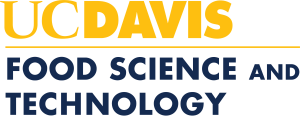A. Specific Learning Outcomes. At the end of this course students will be able to:
- Describe the chemical and physical properties of major food components
- Illustrate how reactive groups of food components play an important role in chemical reactions
- Summarize the major chemical reactions that occur during food processing and storage and how this relates to food quality and shelf-life (e.g. Maillard reaction, enzymatic browning)
- Compare the chemical properties of food components and evaluate changes they undergo during food preparation
- Interpret and report data deriving from the laboratory experiments in a meaningful way (interpretation of microscope slides, analysis of color via spectrophotometry and colorimetry)
- Apply sensory methods of evaluations in food analysis (triangle test, scaling, preference test)
- Write reports summarizing and evaluating experimental data related to making cheese, yogurt and ice cream with different lipid content; baking bread and scones with yeast and chemical leaven; cooking vegetables and evaluating the effect of pH and temperature on plant pigments stability; prepare caramel & fudge utilizing knowledge about the caramelization and Maillard reactions; making emulsions (salad dressing and mayonnaise) and comparing to commercial products.
How this course addresses IFT Core Competencies:
Senior-level course:
FST 101B is a 2 unit lecture and laboratory course in advanced level food chemistry. 101B is a high class enrolment (~200 student) with 1 hour lecture, 3 hours of laboratory per week for each section. Laboratory sections are limited to 26 students to maintain excellence in student learning. Students are required to take an online course and obtain the “ServeSafe Food Handler Certificate”. This requires demonstrated knowledge in: Basic Food Safety, Personal Hygiene, Cross-contamination and Allergens, Time and Temperature, and Cleaning and Sanitation.
FST 101B builds on principles taught in FST100A and complements FST 100B to meet the competencies in the Food Chemistry and Analysis, and Food Safety and Microbiology. sections. In addition, the laboratories meet aspects of Applied Food Science and Success skills required by IFT.
B. Tools used to assess program outcomes.
Bloom’s levels I-VI.
Dr. Barile is a new instructor teaching this course. This course teaches advanced material and requires students to integrate knowledge acquired in previous classes. Assessment varies from quizzes to test knowledge to extensive weekly laboratory reports that require more advanced skills (describing the use of lab and kitchen equipment, applying correct procedures and statistical tests and interpreting experimental data). We use these lab reports in our programmatic assessment of writing skills.
Exam and homework questions in this class tend to cover both knowledge and application. For example, in one lab, students prepare mayonnaise and salad dressing as model emulsion systems. Then, students are required to observe the freshly prepared emulsions at the microscope and compare oil droplet size and oil droplet packing density with commercial mayonnaise and salad dressing. As part of the lab report, students will have to calculate the percentage of fat in mayonnaise and salad dressing and also answer the question whether the products made at the lab could be labeled as such and sold in the USA. In order to answer the question, students will have to critically read the “Code of Federal Regulations” (available on our class’ website) and integrate knowledge acquired in previous courses while extrapolating new information to take a decision (in this case: decide whether the mayonnaise they prepared at the lab can be labeled as such and sold in the USA).
C. Brief summary of assessment results to date.
The instructor meets weekly with the teaching assistants to discuss past and upcoming lab experiments and evaluate lab reports as well as exam results (4 quizzes through the quarter). Together, they also read the “chat” forum that is available on the class web site. This tool is very informative and allow the instructor to get real-time feedback since students use the chat to ask general questions of bring up issues about the assignments. The instructor and the teaching assistants also review the grade distribution after each exam and make sure to cover and discuss the most challenging questions in the lecture immediately following the test. Each year students are asked to complete a course evaluation form for the course. The numerical scores using a scale of 1 (strongly disagree) to 5 (strongly agree) for specific questions as well as verbal comments are compiled. The course and the instructor are evaluated separately.
Students are asked to submit their own feedback on the course with suggestions for course and instructor improvement. These students’ assessments are studied carefully and new strategies are developed to deliver the course content in a more effective manner and to continue to improve learning outcomes. Based on this feedback, the weekly lab instructions will be made available well in advance to give enough time to students who do not have a printer at home, to bring the files to a printing center located in campus. FST 101B was rated as a fun but challenging course.
Future plans: The instructor is considering reducing the number of questions on the lab reports since some students pointed out that “the lab assignments were too time consuming, considering the fact that this class was only a 2-unit class”.
